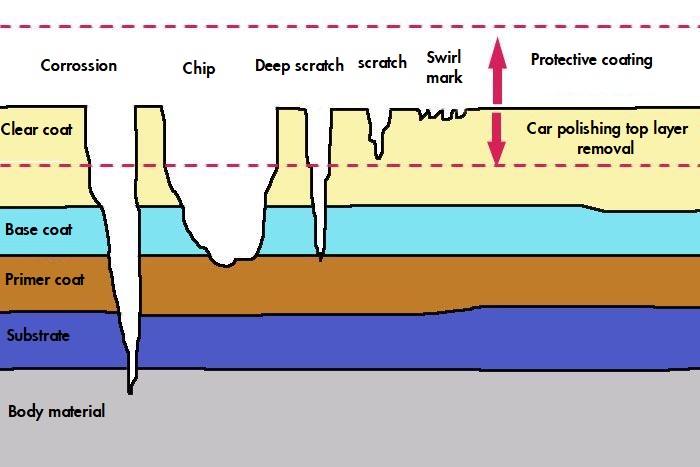Ceramic and Glass coatings have no reference to any type of chemistry. In the USA paint protection coating called Ceramic, while in Japan and the East they are mainly called Glass Coatings.
I see that there is a lot of hype around car detailing in YouTube and Instagram. Ceramic coating is a polymer with additives. As much as it aims to appeal to ceramic, it’s only a polymer (look at safety data sheet. Frequently they called : Polymeric automobile paint sealant).
The popular additives are silicon dioxide (silica, SiO2), which is sourced from natural materials such as quartz and sand. The silicon dioxide is grinded to a very small size particles, hence manufacturer can add word “nano”. This additive is responsible for hydrophobic effect (water repellent).
Some types and brands also use titanium dioxide (titania, Ti02) as an additional hardening agent. It also adds shine, this is mainly dated back to 2018. One of the main disadvantages of having titanium dioxide is your coating them being photo-catalytic, which mean they breakdown organic matter under the sun. This means they were self-destructing.
Graphene, is 2020 “Titanium”. Very easy to use graphene in a coating, by simply adding some powder to it. The challenge with graphene is that its nanoparticles consist of small stacks of graphene that are 1 to 15 nanometers thick, with diameters ranging from sub-micrometer to 100 micrometres. Typical industrially available is 5 micrometer wide. This would mean that you pull most of the graphene out during buffing stage. Should you reduce the size the aspect ratio is damaged, and this black powder no longer called graphene. Hence graphene is not suitable for car paint due to its size, it also not possible to form single thin layer of graphene on the pain by hand.
Nanoparticles TiO2 and SiO2, graphene has been used most in construction industry nanoproducts. A friend who is frequent visitor to China says that “ceramic coating” there costs $4 for 50ml bottle.
Next thing to pay attention is how the people are dressed in those videos. Jeans, long sleeve shirts and so on – a sure sign that people have not idea about what they are talking and selling. Ideally you need to have a special protective equipment meaning no zippers, buttons, etc. as those could leave marks on the car.
What is your car paint layers?
Table. Car paint has following layers and thicknesses including ceramic coating:
| Layer | Thickness in mils (inch /1,000) | Micrometers (mm/1,000) |
| Protective coating | 0.08 | 2 |
| Clear Coat | 1.8-2.8 | 46-71 |
| Base Coat | 1.5 | 38 |
| Primer coat | 0.5-1.5 | 13-38 |
| Substrate | 40 | 1016 |
| Body Material |

Figure. Typical car paint layers thickness and protective coating
As you can see from the ceramic or other any polymer protective coating is very, very thin. Normal piece of paper is 4 mils or 0.1 micrometer. In comparison protective film is 3 mils (76 micrometers).
So, depending on your car condition the actual ceramic coating consumption will vary (remember the coating comes in 30-60 ml bottles).
Ceramic coating unable to protect your car against deep scratches, stone chips. Even hydrophobic properties could be gone in 6-12 months. The other very important aspect when considering ceramic coat application is polishing step. Clear coat on a new car is about 50 micrometers. Depending on the polishing process and condition of your car you will lose 5-10 micrometers every time you do machine polishing. After five applications there is no clear coat left.
Ceramic coating provides marginal protection against UV (same as the most waxes). The only barrier between UV lights and your paint is clear coat. Keep it save.
With the ceramic coating is less than paper thin where the push is coming from?
Its amount of work ceramic coating application generates for the detailers. Preparation work is labor intensive, hence lucrative business.
Reminiscences.
I also thought back about my dad’s car 30 years ago. We never had any stone chips, scratches, or anything like that. Car manufacturers have been perfecting the art of getting the paint as thin as possible to save money.
Waxes and sealants create a removable and replenish able layer of protection to take the brunt of the beating. It is absolutely necessary to keep the clear coat protected if you want it to last a long period of time. Especially red colors. For some reason, reds are just more prone to fading and oxidizing. It has something to do with red absorbing certain wave lengths of light that just do more damage.
Cost Benefit Analysis ceramic coating vs. waxes
With ceramic coating you need to wash and boost the coating anyway. Let’s say you applied coating yourself to save some money. It cost you $150 (including all preparations) and a day of your time.
The best waxes I have tried cost about $50 for 200g tin. It will last 6-12 months.
Maintenance:
Washing will be the same – contactless or handwash only, no automatic washing.
The only difference you need to boost ceramic coating. It will cost you $10-20 USD a year.
If you need to clean your car from snow you need to use air blower only to avoid scratches. Guess which one is easier to re-apply…
For the course of three years, you will spend $200 on ceramic vs. $150 on the waxes. The wax advantage is you can always correct it.